Symplast
Like all creatures and humans, plants need water to thrive and carry out their daily biological operations. Water is essential for germination, photosynthesis, transpiration, and the movement of nutrients from the root to various parts of the plant in all plants. The root absorbs water through its hair and then passes to the plant’s xylem vessels via these three channels:
- The apoplastic pathway
- The symplastic pathway
- The transmembrane pathway
Plants use transportation
Transport tissue is responsible for transportation in plants. Xylem and phloem are two different types of transport tissues.
Water and other low-molecular-weight solutes are transported from the roots to the plant’s top surface via the xylem. The xylem transports water throughout the plant. All amino acids and sucrose, on the other hand, are transferred to different areas of the plant via phloem transport. Many elongated dead cells are positioned from end to end in mature xylem to form a continuous channel or tube. Various tubes are employed to deliver water to plants.

Tubes of the Mature Xylem:
There is no room for cytoplasm.
Are water-resistant.
Have thick walls with lignin, which is a woody substance.
Because a single tree contains several xylem tissues, xylem transport is particularly important in plants. One can define mobility in plants in this way.
Phloem is the pathway responsible for providing food downward direction i.e., from the leaves to the rest of the plant.
The major process for water movement in plants is water from the soil to enter the plant through the root hairs and then pass into the xylem through other root cells. In contrast to the xylem, phloem now has living cells that are arranged end to end. Phloem is made up of cytoplasm that travels from one cell to the next through various pores.
Different amino acids and sucrose are transported up and down the phloem in the plant. Between the sources and the sinks, this process occurs. It’s similar to where chemicals are made and where they’re used or dumped. This entire process is referred to as translocation. The xylem and phloem transport systems are critical for plant growth.
What exactly is Symplast?
Symplast refers to the protoplasts found in plants that are linked by plasmodesmata. The inner component of the plasma membrane is responsible for transferring water and other low-molecular-weight solutes such as carbohydrates, amino acids, and other ions between cells. Priestley coined the phrase “symplastic route” in 1949 after seeing the active and passive water transport in plants.
The plasma membranes surround the Symplast, which is the innermost section of the plant. It connects the cytoplasm of plant cells by connecting a network of plasmodesmata. Symplast is the live component of the plant tissue that lacks cell walls and intercellular gaps. The symplastic pathway is the pathway generated by the Symplast. The cell sap is the first thing that absorbs water absorbed from the soil. After passing through cell sap, water moves from one cell, and this pathway continues.
Why is Symplast regarded as a living component of plant tissue?
As symplast contain a network of plasmodesmata connected with protoplasts which is considered as living part of the cell. That’s why Symplast is considered the living part of the plant tissue even without the presence of a cell wall or intercellular gaps.
The symplast and apoplast are two types of plant tissue. The cytoplasmic symplast is located on the inner side of the plasma membrane, whereas the apoplast, often known as a cell wall, is located on the outer side of the cell.
When the transportation process begins, the solutes travel through apoplastic transport to the endodermal cells. Because the Casparian strip is occupied, these solutes are pushed into the symplastic route. When all the solutes have been peacefully digested, they reach the pericycle. They are then transferred from the pericycle to the xylem, where long-distance transport takes place. As it involves cell wall transfer, xylem transport differs significantly from the apoplastic flow.
